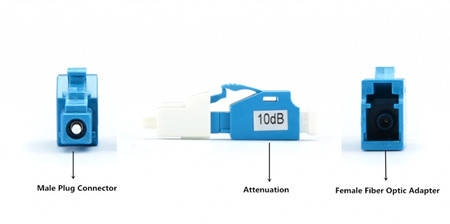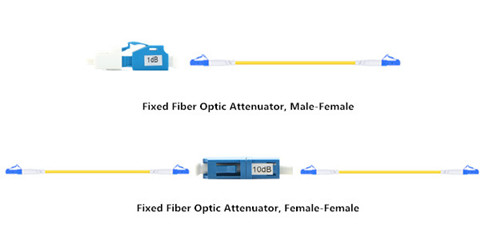Marketing
Introduction to Fiber Optic Attenuator
Fiber optic attenuators are often used to control the optical signal strength in fiber optic links. For example, in a DWDM based system, the DWDM employs multiple wavelengths and channels in different communication protocols and bit rates requiring precise tuning of the power levels of the channel signals. Fiber optic attenuators are often used to adjust the optical power signal strength. How exactly does the fiber optic attenuator work? This article might provide you some information.
What Is Fiber Optic Attenuator?
A fiber optic attenuator, also called as an optical attenuator, can simulate the optical loss that could be caused by a long period of fiber. Put it simply, for a fiber optic receiver, too much light can overload it and degrade the bit error ratio. Therefore, the light power at the receiver end should be reduced. Fiber optic attenuators fit the requirement perfectly. This usually happen when the transmitter delivers too much power like the single-mode system, or the transmitter is simply too near to the receiver. Optical attenuators can be divided into two types—fixed and variable attenuators.
Fixed Fiber Optic Attenuators
Fixed fiber optic attenuator, also called fixed plug type or fixed build-out fiber optic attenuator, is used in fiber optic communications to reduce the optical fiber power by a certain level. Fixed fiber optic attenuators have fixed values that are specified in decibels from 1dB to 30dB. Usually, it has a male plug connector at one side to allow the attenuator to be plugged directly into receiver equipment or adapters in patch panel, and has female type fiber optic adapter at the other side to allow the patch cords to plug in (seen in the below image).

Fixed fiber optic attenuator is based on the connector type and the attenuation level. For instance, LC 10dB fixed fiber optic attenuator means this attenuator use LC fiber optic connector, and it can reduce the optical fiber power level by 10dB. Their applications include telecommunication networks, optical fiber test facility, LAN and CATV systems.
Variable Fiber Optic Attenuators
Variable fiber optic attenuators (or adjustable fiber optic attenuator) are with adjustable attenuation range. It usually is inline type, the appearance like fiber optic patch cord; it is with an adjustable component in the middle of the device to change the attenuation level to a certain figure. There are also handheld variable fiber optic attenuators; they are used as test equipment, and we have the inline fiber optic attenuators.
How to Use Fixed Fiber Optic Attenuator?
In general, multimode systems do not need attenuators as the multimode sources, VCSELs, rarely have enough power output to saturate receivers. Instead, single-mode systems, especially short links, often have too much power and need optical attenuators. Therefore, fixed fiber optic attenuators are usually single-mode types. Fixed fiber optic attenuators should be always installed at the receiver end of the link (X in the drawing). This is because it’s more convenient to test the receiver power before and after attenuation or while adjusting it with your power meter at the receiver, plus any reflectance will be attenuated on its path back to the source.

For female to male fixed fiber optic attenuators, we can plug the fiber cable to the female fiber optic adapter of the attenuator. And then plug the male plug connector of the attenuator to the equipment directly. For female to female fixed fiber optic attenuators, we should plug the two patch cords to the two female fiber optic adapter of the attenuator (shown in the above figure).
Conclusion
Optical attenuators can be divided into four classes depending on the type of ports, namely, SC, LC, FC, ST optical attenuators. FS.COM as a attenuator manufacturer, provide several types of attenuator as well as other related products such as adapter, multiplexer, optical converter and so on. Our fixed fiber optic attenuators offer low return loss, high mode stability and a variety of attenuation values. Even you are not clear about some specifications which you need, you can directly visit the fiber store.
Post je objavljen 09.11.2016. u 03:45 sati.